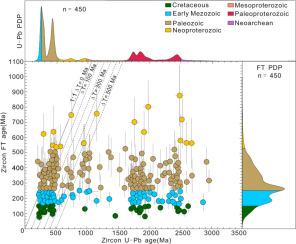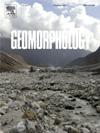Paleozoic-Mesozoic multistage tectonic evolution of the North Qilian Shan revealed by detrital zircon U-Pb and fission-track double dating
IF 3.1
2区 地球科学
Q2 GEOGRAPHY, PHYSICAL
引用次数: 0
Abstract
Knowledge of the tectonic history of the North Qilian Shan contributes to our understanding of the formation of the Tibetan Plateau. However, when the North Qilian Shan were formed has been controversial. We report new detrital zircon U-Pb (n = 899) and double dating fission track and U-Pb (n = 450) results from nine samples of Lower Cretaceous and Oligocene sandstone units, integrating with published geochronology and thermochronology data in order to reconstruct the evolution history of the North Qilian Shan. Nine samples from this unit show detrital zircon fission track age populations that center at: 636–603, 495, 406–331, 290–266, 247–224, 193–151, and 144–102 Ma. These fission track data are older than their corresponding depositional ages, suggesting that the fission track ages are unreset and record magmatic-related cooling or exhumation stages of the North Qilian Shan since the Late Neoproterozoic. Deconvolved fission track peak ages document major cooling events associated with the opening of the North Qilian Ocean at 636–603 Ma. Late Cambrian peak age (495 Ma) is attributed to the early phase of the subduction of the North Qilian Ocean. The Devonian period exhibited a cooling phase between 406 and 381 Ma, corresponding to the collision event between the Qaidam terrane, Central Qilian Shan, and Alxa Block. The peak age of 331 Ma signifies the cooling event associated with the subduction of the Paleo-Asian Ocean. The peak ages during the Early-Middle Permian period (290–266 Ma) provide evidence of significant exhumation events that occurred during the Late Paleozoic era. These events were linked to the subduction of the Paleo-Tethys Ocean to the south and the Paleo-Asian Ocean to the north. The Triassic peak ages (247–224 Ma) unveil exhumation signals in the North Qilian Shan region that were generated by the far-field effect of the collision between the Qiangtang and Kunlun terranes. During the Jurassic (193–151 Ma) and the Early Cretaceous periods (144–102 Ma), the exhumation of the North Qilian Shan region was a consequence of the subduction of the Neo-Tethys Ocean and the collision between the Lhasa and Qiangtang blocks, respectively. The peak ages of the Xinminpu Formation in the Early Cretaceous (123–121 Ma) are in close proximity to their depositional age (125–105 Ma), indicating that the North Qilian Shan underwent rapid exhumation during this period. The peak ages observed in the Oligocene Baiyanghe Formation (31–24 Ma) from 144 to 102 Ma, indicate that it has been influenced by the recycled sediments originating from the Cretaceous Xinminpu Formation. The North Qilian Shan gradually emerged during the late Paleozoic and Mesozoic eras, providing the foundation for its subsequent reactivation in the Cenozoic era. The multi-stage cooling or exhumation events of North Qilian Shan since Late Neoproterozoic reflect the complex formation process of the northeastern margin of Tibetan Plateau.

锆英石U-Pb和裂变轨道双重测年揭示北祁连山古生代-中生代多期构造演化过程
对北祁连山构造历史的了解有助于我们理解青藏高原的形成。然而,北祁连山是何时形成的一直存在争议。我们报告了9个下白垩统和渐新统砂岩单元样品的新的碎屑锆石U-Pb(n = 899)和双测年裂变轨迹及U-Pb(n = 450)结果,并与已发表的地质年代学和热时学数据相结合,以重建北祁连山的演化历史。来自该单元的九个样品显示出以下列位置为中心的锆英石裂变轨迹年龄群:636-603、495、406-331、290-266、247-224、193-151 和 144-102 Ma。这些裂变轨迹数据比相应的沉积年龄要早,表明裂变轨迹年龄是未重置的,记录了北祁连山自新新生代晚期以来与岩浆有关的冷却或掘起阶段。经解卷的裂变轨迹峰值年龄记录了与北祁连洋开辟有关的主要冷却事件,时间为636-603 Ma。寒武纪晚期的峰值年龄(495 Ma)归因于北祁连洋俯冲的早期阶段。泥盆纪在406-381Ma之间出现冷却阶段,与柴达木地层、中祁连山和阿拉善地块之间的碰撞事件相对应。331Ma的峰值年龄标志着与古亚洲洋俯冲有关的冷却事件。二叠纪早中期(290-266Ma)的峰值年龄为晚古生代发生的重大掘起事件提供了证据。这些事件与南面的古泰西洋和北面的古亚洲洋的俯冲有关。三叠纪峰值年龄(247-224Ma)揭示了北祁连山地区的掘起信号,这些信号是由羌塘地块和昆仑地块碰撞的远场效应产生的。在侏罗纪(193-151Ma)和早白垩世(144-102Ma),北祁连山地区的隆升分别是新特提斯洋俯冲和拉萨地块与羌塘地块碰撞的结果。新民铺地层在早白垩世的峰值年龄(123-121Ma)与其沉积年龄(125-105Ma)相近,表明北祁连山地区在这一时期经历了快速的隆升。渐新世白杨河地层(31-24Ma)的峰值年龄为144-102Ma,表明该地层受到了白垩纪新民铺地层再生沉积的影响。北祁连山在晚古生代和中生代逐渐崛起,为其后在新生代的重新活跃奠定了基础。北祁连山自新新生代晚期以来的多期冷却或掘起事件,反映了青藏高原东北缘复杂的形成过程。
本文章由计算机程序翻译,如有差异,请以英文原文为准。
求助全文
约1分钟内获得全文
求助全文
来源期刊

Geomorphology
地学-地球科学综合
CiteScore
8.00
自引率
10.30%
发文量
309
审稿时长
3.4 months
期刊介绍:
Our journal''s scope includes geomorphic themes of: tectonics and regional structure; glacial processes and landforms; fluvial sequences, Quaternary environmental change and dating; fluvial processes and landforms; mass movement, slopes and periglacial processes; hillslopes and soil erosion; weathering, karst and soils; aeolian processes and landforms, coastal dunes and arid environments; coastal and marine processes, estuaries and lakes; modelling, theoretical and quantitative geomorphology; DEM, GIS and remote sensing methods and applications; hazards, applied and planetary geomorphology; and volcanics.
 求助内容:
求助内容: 应助结果提醒方式:
应助结果提醒方式:


